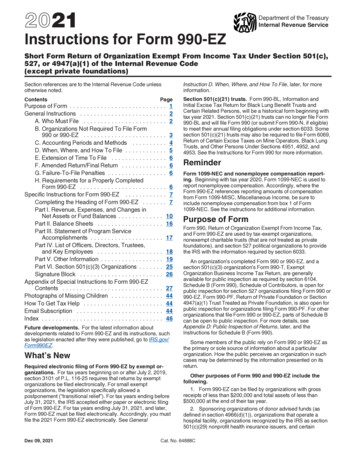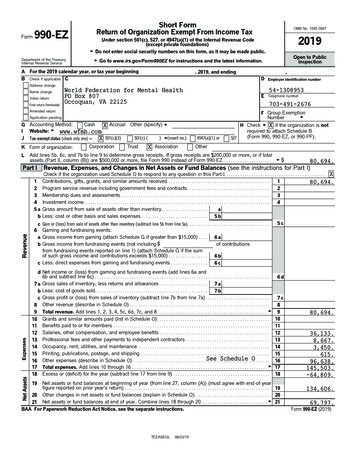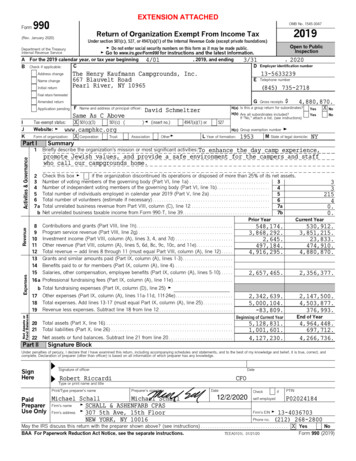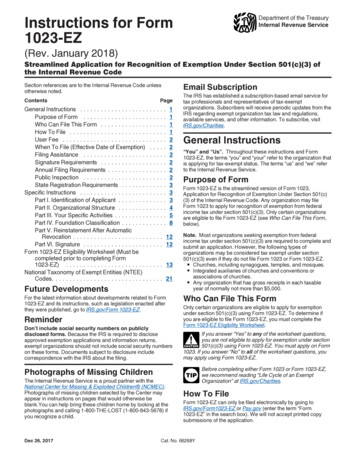
Transcription
2021Instructions for Form 990-EZDepartment of the TreasuryInternal Revenue ServiceShort Form Return of Organization Exempt From Income Tax Under Section 501(c),527, or 4947(a)(1) of the Internal Revenue Code(except private foundations)Section references are to the Internal Revenue Code unlessotherwise noted.Instruction D. When, Where, and How To File, later, for moreinformation.ContentsSection 501(c)(21) trusts. Form 990-BL, Information andInitial Excise Tax Return for Black Lung Benefit Trusts andCertain Related Persons, will be a historical form beginning withtax year 2021. Section 501(c)(21) trusts can no longer file Form990-BL and will file Form 990 (or submit Form 990-N, if eligible)to meet their annual filing obligations under section 6033. Somesection 501(c)(21) trusts may also be required to file Form 6069,Return of Certain Excise Taxes on Mine Operators, Black LungTrusts, and Other Persons Under Sections 4951, 4952, and4953. See the Instructions for Form 990 for more information.Purpose of Form . . . . . . . . . . . . . . . . . . . . . . .General Instructions . . . . . . . . . . . . . . . . . . . .A. Who Must File . . . . . . . . . . . . . . . . . . .B. Organizations Not Required To File Form990 or 990-EZ . . . . . . . . . . . . . . . . . . .C. Accounting Periods and Methods . . . . .D. When, Where, and How To File . . . . . . .E. Extension of Time To File . . . . . . . . . . .F. Amended Return/Final Return . . . . . . . .G. Failure-To-File Penalties . . . . . . . . . . . .H. Requirements for a Properly CompletedForm 990-EZ . . . . . . . . . . . . . . . . . . . .Specific Instructions for Form 990-EZ . . . . . . .Completing the Heading of Form 990-EZ . .Part I. Revenue, Expenses, and Changes inNet Assets or Fund Balances . . . . . . . . .Part II. Balance Sheets . . . . . . . . . . . . . . .Part III. Statement of Program ServiceAccomplishments . . . . . . . . . . . . . . . . .Part IV. List of Officers, Directors, Trustees,and Key Employees . . . . . . . . . . . . . . .Part V. Other Information . . . . . . . . . . . . . .Part VI. Section 501(c)(3) Organizations . . .Signature Block . . . . . . . . . . . . . . . . . . . .Appendix of Special Instructions to Form 990-EZContents . . . . . . . . . . . . . . . . . . . . . . . . .Photographs of Missing Children . . . . . . . . . . .How To Get Tax Help . . . . . . . . . . . . . . . . . . .Email Subscription . . . . . . . . . . . . . . . . . . . . .Index . . . . . . . . . . . . . . . . . . . . . . . . . . . . . . .Page. 1. 2. 2.345666. 6. 7. 7. . . . 10. . . . 16. . . . 17.18192526.2744444446Future developments. For the latest information aboutdevelopments related to Form 990-EZ and its instructions, suchas legislation enacted after they were published, go to IRS.gov/Form990EZ.What’s NewRequired electronic filing of Form 990-EZ by exempt organizations. For tax years beginning on or after July 2, 2019,section 3101 of P.L. 116-25 requires that returns by exemptorganizations be filed electronically. For small exemptorganizations, the legislation specifically allowed apostponement (“transitional relief”). For tax years ending beforeJuly 31, 2021, the IRS accepted either paper or electronic filingof Form 990-EZ. For tax years ending July 31, 2021, and later,Form 990-EZ must be filed electronically. Accordingly, you mustfile the 2021 Form 990-EZ electronically. See GeneralDec 09, 2021ReminderForm 1099-NEC and nonemployee compensation reporting. Beginning with tax year 2020, Form 1099-NEC is used toreport nonemployee compensation. Accordingly, where theForm 990-EZ references reporting amounts of compensationfrom Form 1099-MISC, Miscellaneous Income, be sure toinclude nonemployee compensation from box 1 of Form1099-NEC. See the instructions for additional information.Purpose of FormForm 990, Return of Organization Exempt From Income Tax,and Form 990-EZ are used by tax-exempt organizations,nonexempt charitable trusts (that are not treated as privatefoundations), and section 527 political organizations to providethe IRS with the information required by section 6033.An organization's completed Form 990 or 990-EZ, and asection 501(c)(3) organization's Form 990-T, ExemptOrganization Business Income Tax Return, are generallyavailable for public inspection as required by section 6104.Schedule B (Form 990), Schedule of Contributors, is open forpublic inspection for section 527 organizations filing Form 990 or990-EZ. Form 990-PF, Return of Private Foundation or Section4947(a)(1) Trust Treated as Private Foundation, is also open forpublic inspection for organizations filing Form 990-PF. For otherorganizations that file Form 990 or 990-EZ, parts of Schedule Bcan be open to public inspection. For more details, seeAppendix D: Public Inspection of Returns, later, and theInstructions for Schedule B (Form 990).Some members of the public rely on Form 990 or 990-EZ asthe primary or sole source of information about a particularorganization. How the public perceives an organization in suchcases may be determined by the information presented on itsreturn.Other purposes of Form 990 and 990-EZ include thefollowing.1. Form 990-EZ can be filed by organizations with grossreceipts of less than 200,000 and total assets of less than 500,000 at the end of their tax year.2. Sponsoring organizations of donor advised funds (asdefined in section 4966(d)(1)), organizations that operate ahospital facility, organizations recognized by the IRS as section501(c)(29) nonprofit health insurance issuers, and certainCat. No. 64888C
A. Who Must Filecontrolling organizations defined in section 512(b)(13) must fileForm 990 rather than Form 990-EZ regardless of the amount oftheir gross receipts and total assets. See the instructions forlines 44 and 45, and General Instruction A. Who Must File, later,before completing this form.3. Form 990-EZ can’t be used by a private foundationrequired to file Form 990-PF. A section 501(c)(3) or section4947(a)(1) organization should refer to the Instructions forSchedule A (Form 990), Public Charity Status and PublicSupport, to determine whether it is a private foundation.4. Form 990 must be used to file a group return, not Form990-EZ. See General Instruction A, later.Most organizations exempt from income tax under section501(a) must file an annual information return (Form 990 or990-EZ) or submit an annual electronic notice (Form 990-N,Electronic Notice (e-Postcard) for Tax-Exempt OrganizationsNot Required To File Form 990 or Form 990-EZ), dependingupon the organization's gross receipts and total assets.Form 990-EZ. If an organization has gross receipts less than 200,000 and total assets at the end of the year less than 500,000, it can file Form 990-EZ, instead of Form 990. But seethe special rules later regarding Section 501(c)(21) black lungtrusts, Sponsoring organizations of donor advised funds,Organizations that operate one or more hospital facilities,Section 501(c)(29) nonprofit health insurance issuers, andControlling organizations described in section 512(b)(13).General InstructionsOverview of Form 990-EZ. Form 990-EZ is an annualinformation return required to be filed with the IRS by manyorganizations exempt from income tax under section 501(a), andcertain political organizations and nonexempt charitable trusts.Parts I through V of the form must be completed by all filingorganizations (Part VI must be completed by section 501(c)(3)organizations and section 4947(a)(1) nonexempt charitabletrusts), and require reporting on the organization's exempt andother activities, finances, compliance with certain federal taxfilings and requirements, and compensation paid to certainpersons. Additional schedules are required to be completeddepending on the activities and type of organization. Thecompleted Form 990-EZ filed with the IRS, except for certaincontributor information on Schedule B (Form 990), is required tobe made available to the public by the IRS and the filingorganization (see Appendix D, later). Also, the organization maybe required to file the completed Form 990-EZ with stategovernments to satisfy state reporting requirements. SeeAppendix G: Use of Form 990 or 990-EZ To Satisfy StateReporting Requirements, later.Form 990. Form 990 (not 990-EZ or 990-N) must be filed by anorganization exempt from income tax under section 501(a)(including an organization that hasn’t applied for recognition ofexemption or whose application for recognition of exemption ispending) if it has either gross receipts greater than or equal to 200,000 or total assets greater than or equal to 500,000 at theend of the tax year (with exceptions described below fororganizations eligible to submit Form 990-N and for certainorganizations described in General Instruction B. OrganizationsNot Required To File Form 990 or 990-EZ, later). Organizationsthat must file include the following. Organizations described in section 501(c)(3) (other thanprivate foundations). Organizations described in other section 501(c) subsections.Gross receipts. Gross receipts are the total amounts theorganization received from all sources during its annualaccounting period, without subtracting any costs or expenses.See Appendix B: How To Determine Whether an Organization'sGross Receipts Are Normally 50,000 (or 5,000) or Less, later,for a discussion of gross receipts. Total assets is the amountreported by the organization on its balance sheet (Form 990-EZ,Part II, line 25, column (B)) as of the end of the year, withoutreduction for liabilities.For purposes of Form 990 or Form 990-EZ reporting, the term“section 501(c)(3)” includes organizations exempt undersections 501(e) and (f) (cooperative service organizations),501(j) (amateur sports organizations), 501(k) (childcareorganizations), and 501(n) (charitable risk pools). In addition,any organization described in one of these sections is alsosubject to section 4958 if it obtains a determination letter fromthe IRS stating that it is described in section 501(c)(3).Reminder: Do Not Include SocialSecurity Number on PubliclyDisclosed FormsBecause the filing organization and the IRS are required topublicly disclose the organization’s annual information returns,social security numbers shouldn’t be included on this form.Documents subject to disclosure include schedules andattachments filed with the form. For more information, seeAppendix D, later.Organizations that have total gross income fromunrelated trades or businesses of at least 1,000 areCAUTION also required to file Form 990-T in addition to anyrequired Form 990, 990-EZ, or 990-N.Form 990-N. If an organization normally has annual grossreceipts of 50,000 or less, it must submit Form 990-N if itdoesn’t file Form 990 or Form 990-EZ (with exceptionsdescribed later for certain section 509(a)(3) supportingorganizations and for certain organizations described in GeneralInstruction B, later). If the organization chooses to file Form990-EZ, be sure to file a complete return. See Appendix B, later,for a discussion of gross receipts and General Instruction H.Requirements for a Properly Completed Form 990-EZ, later, fora discussion of a complete return.!Helpful hints. The following hints may help you more efficientlyreview these instructions and complete the form.1. Throughout these instructions, “the organization” and the“filing organization” both refer to the organization filing Form990-EZ.2. The examples appearing throughout these instructionsare illustrative only and for the purpose of completing Form990-EZ, but aren’t all-inclusive.3. Instructions for the Form 990-EZ schedules are publishedseparately from these instructions.4. Unless otherwise specified, information should beprovided for the organization’s tax year. For instance, anorganization should answer “Yes” to a question asking whether itconducted a certain type of activity only if it conducted thatactivity during the tax year.Electronic filing. Organizations are required to file Form990-EZ electronically. See General Instruction D. When, Where,and How To File, later.Foreign and U.S. possession organizations. Foreignorganizations and U.S. possession organizations, as well asdomestic organizations described above, must file Form 990 or990-EZ unless specifically excepted under General InstructionB, later. Report amounts in U.S. dollars, and state whatconversion rate the organization uses. Combine amounts from-2-2021 Instructions for Form 990-EZ
4947(a)(1) trusts must complete all sections of the Form 990-EZand schedules that 501(c)(3) organizations must complete. Allreferences to a section 501(c)(3) organization in Form 990-EZ,schedules, and instructions include a section 4947(a)(1) trust(for instance, such a trust must complete Schedule A (Form990)), unless otherwise specified. If such a trust doesn’t haveany taxable income under subtitle A of the Code, it can file Form990 or Form 990-EZ to meet its section 6012 filing requirementand doesn’t have to file Form 1041, U.S. Income Tax Return forEstates and Trusts.within and outside the United States and report the total for eachitem. All information must be written in English.Section 501(c)(21) black lung trusts. The trustee of a trustexempt from tax under section 501(a) and described in section501(c)(21) must file Form 990 and not Form 990-EZ, unless thetrust normally has gross receipts in each tax year of not morethan 50,000 and can file Form 990-N.Sponsoring organizations of donor advised funds.Sponsoring organizations of donor advised funds (as defined insection 4966(d)(1)) must file Form 990 and not Form 990-EZ.See line 44a and the related instructions.Group returns. A group return filed by the central or parentorganization on behalf of the subordinates in a group exemptionmust be filed using Form 990, not Form 990-EZ.Organizations that operate one or more hospital facilities.Organizations that operated one or more hospital facilities duringthe tax year must file Form 990, and not Form 990-EZ, andcomplete Schedule H (Form 990), Hospitals. A “hospital facility”is a facility that is required to be licensed, registered, or similarlyrecognized by a state as a hospital. See line 44b and the relatedinstructions.Returns when exempt status not established. Anorganization is required to file Form 990 or 990-EZ inaccordance with these instructions if the organization claimsexempt status under section 501(a) but hasn’t established suchexempt status by filing Form 1023, Application for Recognition ofExemption Under Section 501(c)(3) of the Internal RevenueCode; Form 1023-EZ, Streamlined Application for Recognition ofExemption Under Section 501(c)(3) of the Internal RevenueCode; Form 1024, Application for Recognition of ExemptionUnder Section 501(a); or Form 1024-A, Application forRecognition of Exemption Under Section 501(c)(4) of theInternal Revenue Code, and receiving an IRS determinationletter recognizing exempt status. In such cases, the organizationmust check the “Application pending” checkbox in Item B of theForm 990 or 990-EZ header (whether or not a Form 1023,1023-EZ, 1024, or 1024-A has been filed) to indicate that Form990 or 990-EZ is being filed in the belief that the organization isexempt under section 501(a).To qualify for recognition of tax exemption retroactive to itsdate of organization or formation, an organization claimingtax-exempt status must generally file Form 1023, 1023-EZ,1024, or 1024-A within 27 months of the end of the month inwhich it was legally organized or formed.Section 501(c)(29) nonprofit health insurance issuers.Nonprofit health insurance issuers described in section 501(c)(29) must file Form 990 and not Form 990-EZ.Controlling organizations described in section 512(b)(13).A controlling organization of one or more controlled entities, asdescribed in section 512(b)(13), must file Form 990 and notForm 990-EZ if it is required to file an annual information returnfor the year and if there was a certain type of transfer of fundsbetween the controlling organization and any controlled entityduring the year. See line 45 and the related instructions.Section 509(a)(3) supporting organizations. A section509(a)(3) supporting organization must file Form 990 or 990-EZ,even if its gross receipts are normally 50,000 or less, and evenif it is described in Rev. Proc. 96-10, 1996-1 C.B. 577, or is anaffiliate of a governmental unit described in Rev. Proc. 95-48,1995-2 C.B. 418, unless it qualifies as one of the following.1. An integrated auxiliary of a church, as described inRegulations section 1.6033-2(h).2. The exclusively religious activities of a religious order.3. An organization whose gross receipts are normally notmore than 5,000 that supports a section 501(c)(3) religiousorganization.B. Organizations Not Required To FileForm 990 or 990-EZAn organization described below doesn’t have to file Form 990or 990-EZ even if it has at least 200,000 of gross receipts or 500,000 total assets at the end of the tax year (except forsection 509(a)(3) supporting organizations described in GeneralInstruction A). See General Instruction A, earlier, for determiningwhether the organization can file Form 990-EZ instead of Form990. An organization described in item 10 or 11 under Certainorganizations with limited gross receipts, later, is required tosubmit Form 990-N unless it voluntarily files Form 990 or990-EZ, as applicable.If the organization is described in (3), then it must submitForm 990-N unless it voluntarily files Form 990 or 990-EZ.Section 501(c)(7) and 501(c)(15) organizations. Section501(c)(7) and 501(c)(15) organizations apply the same grossreceipts test as other organizations to determine whether theymust file a Form 990 or 990-EZ, but use a different definition ofgross receipts to determine whether they qualify as tax exemptfor the tax year. See Appendix C: Special Gross Receipts Testsfor Determining Exempt Status of Section 501(c)(7) and Section501(c)(15) Organizations, later, for more information.Certain religious organizations1. A church, an interchurch organization of local units of achurch, a convention or association of churches, or anintegrated auxiliary of a church as described in Regulationssection 1.6033-2(h) (such as a men's or women's organization,religious school, mission society, or youth group).2. A church-affiliated organization that is exclusivelyengaged in managing funds or maintaining retirement programsand is described in Rev. Proc. 96-10. But see the filingrequirements for section 509(a)(3) supporting organizations inGeneral Instruction A, earlier.3. A school below college level affiliated with a church oroperated by a religious order, as described in Regulationssection 1.6033-2(g)(1)(vii).4. A mission society sponsored by, or affiliated with, one ormore churches or church denominations, if more than half of theSection 527 political organizations. Tax-exempt politicalorganizations must file Form 990 or 990-EZ unless their annualgross receipts are less than 25,000 during the tax year or theyare otherwise excepted under General Instruction B, later. Asection 527 political organization that is a qualified state or localpolitical organization must file Form 990 or 990-EZ only if it hasgross receipts of 100,000 or more. Political organizations aren’trequired to submit Form 990-N.Section 4947(a)(1) nonexempt charitable trusts. Anonexempt charitable trust described under section 4947(a)(1)(if it isn’t treated as a private foundation) is required to file Form990 or 990-EZ unless excepted under General Instruction B,later. Such a trust is treated like an exempt section 501(c)(3)organization for purposes of completing the form. Section2021 Instructions for Form 990-EZ-3-
A public charity described in section 170(b)(1)(A)(iv) orsociety's activities are conducted in, or directed at, persons inforeign countries.5. An exclusively religious activity of any religious orderdescribed in Rev. Proc. 91-20, 1991-1 C.B. 524.Certain governmental organizations6. A state institution whose income is excluded from grossincome under section 115.7. A governmental unit or affiliate of a governmental unitdescribed in Rev. Proc. 95-48. But see the filing requirements forsection 509(a)(3) supporting organizations in General InstructionA, earlier.8. An organization described in section 501(c)(1). A section501(c)(1) organization is a corporation organized under an act ofCongress that is an instrumentality of the United States, andexempt from federal income taxes.Certain political organizations9. A political organization that is: A state or local committee of a political party, A political committee of a state or local candidate, A caucus or association of state or local officials, or Required to report under the Federal Election Campaign Actof 1971 as a political committee (as defined in section 301(4) ofsuch Act).Certain organizations with limited gross receipts10. An organization whose gross receipts are normally 50,000 or less. Such organizations are generally required tosubmit Form 990-N if they choose not to file Form 990 or990-EZ. To determine what an organization's gross receipts“normally” are, see Appendix B, later.11. Foreign organizations and organizations located in U.S.possessions, whose gross receipts from sources within theUnited States are normally 50,000 or less, and which didn’tengage in significant activity in the United States (other thaninvestment activity). Such organizations, if they claim U.S. taxexemption or are recognized by the IRS as tax exempt, aregenerally required to submit Form 990-N if they choose not to fileForm 990 or 990-EZ.If a foreign organization or organization located in a U.S.possession is required to file a Form 990 or 990-EZ, then itsworldwide gross receipts, as well as assets, are taken intoaccount in determining whether it qualifies to file Form 990-EZ.To determine what an organization's gross receipts normally are,see Appendix B, later.Certain organizations that file different kinds of annualinformation returns12. A private foundation (including a private operatingfoundation) exempt under section 501(c)(3) and described insection 509(a). Use Form 990-PF for a taxable privatefoundation, a section 4947(a)(1) nonexempt charitable trusttreated as a private foundation, and a private foundationterminating its status by becoming a public charity under section507(b)(1)(B) for tax years within its 60-month termination period.If the section 507(b)(1)(B) organization successfully terminates,then it files Form 990 or 990-EZ in its final year of termination.13. A religious or apostolic organization described in section501(d). Use Form 1065, U.S. Return of Partnership Income.14. A stock bonus, pension, or profit-sharing trust thatqualifies under section 401. Use Form 5500, Annual Return/Report of Employee Benefit Plan.TIP (vi) or 509(a)(2) that isn’t within its initial 5 years ofexistence should first complete Part II or III ofSchedule A (Form 990) to ensure that it continues to qualify as apublic charity for the tax year. If it fails to qualify as a publiccharity, then it must file Form 990-PF rather than Form 990-EZ.C. Accounting Periods and MethodsAccounting PeriodsCalendar year. Use the 2021 Form 990-EZ to report on the2021 calendar year accounting period. A calendar yearaccounting period begins on January 1 and ends on December31.Fiscal year. If the organization has established a fiscal yearaccounting period, use the 2021 Form 990-EZ to report on theorganization's fiscal year that began in 2021 and ended 12months later. A fiscal year accounting period should normallycoincide with the natural operating cycle of the organization. Becertain to indicate in the heading of Form 990-EZ the date theorganization's fiscal year began in 2021 and the date the fiscalyear ended in 2022.Short period. A short accounting period is a period of less than12 months, which exists when an organization first commencesoperations, changes its accounting period, or terminates. If theorganization's short year began in 2021 and ended beforeDecember 31, 2021 (not on or after December 31, 2021), it mayuse either 2020 Form 990-EZ or 2021 Form 990-EZ or Form 990to file for such short year. The 2021 form may also be used for ashort period beginning in 2022 and ending before December 31,2022 (not on or after December 31, 2022). When doing so,provide the information for designated years listed on the return,other than the tax year being reported, as if the years shown inthe form text and headings were updated.For example, if filing for a short period beginning in 2022 onthe 2021 Form 990-EZ, provide the information in Schedule A(Form 990), Part II, for the tax years 2018 through 2022, ratherthan for tax years 2017 through 2021.Accounting period change. If the organization changes itsaccounting period, it must file a Form 990-EZ for the short periodresulting from the change. Enter “Change of Accounting Period”at the top of this short-period return if it is being filed on the 2020Form 990-EZ.If the organization has previously changed its annualaccounting period at any time within the 10-calendar-year periodthat includes the beginning of the short period resulting fromthe current change in accounting period, and it had a Form990 series or income tax return filing requirement at any timeduring that 10-year period, it must also file a Form 1128,Application To Adopt, Change, or Retain a Tax Year, with theshort-period return. See Rev. Proc. 85-58, 1985-2 C.B. 740.If an organization that submits Form 990-N changes itsaccounting period, it must report this change on Form 990,990-EZ, or 1128, or by sending a letter to:Internal Revenue Service1973 Rulon White Blvd.Ogden, UT 84201Accounting MethodsAn “accounting method,” for federal income tax purposes, is apractice a taxpayer follows to determine the year in which toreport revenue and expenses for federal income tax purposes.An accounting method includes not only the overall plan ofaccounting for gross income or deductions (for example, anaccrual method or the cash receipts and disbursement method),Subordinate organizations in a group exemption whichTIP are included in a group return filed for the tax year by thecentral organization shouldn’t file a separate Form 990or 990-EZ, or submit Form 990-N for the tax year.-4-2021 Instructions for Form 990-EZ
990-T solely due to owing a section 6033(e)(2) proxy tax doesnot have to request consent to change its method for reportingthe item.but also the treatment of an item used in such overall plan.However, a practice that does not affect the timing for reportingan item of income or deduction for purposes of determiningtaxable income is not an accounting method. A taxpayer,including a tax-exempt entity, generally adopts any permissibleaccounting method in the first year in which it uses the method indetermining its taxable income. See Rev. Proc. 2015-13, 2015-5I.R.B. 419.Adjustments required when changing an accounting method. A taxpayer, including a tax-exempt entity, that changes itsaccounting method must generally calculate and report anadjustment to ensure that no portion of the item being changedis permanently omitted or duplicated (see section 481(a)).However, depending on the specific method change, the IRSmay provide that an adjustment is not required or permitted. Anorganization must report any adjustment required by section481(a) in Part I, line 20 (other changes in net assets or fundbalances) as a net asset adjustment made during the tax year.The organization must explain in Schedule O (Form 990),Supplemental Information to Form 990 or 990-EZ, the changeand net asset adjustment.An exempt organization may adopt an accountingmethod not only for purposes of calculating taxableCAUTION income, but also for purposes of determining whethertaxable income will be subject to federal income tax. Forexample, a tax-exempt entity may adopt an accounting methodfor an item of income from an unrelated trade or business activityeven if the gross income from such activity is less than 1,000and is therefore not taxed for federal income tax purposespursuant to Regulations section 1.6012-2(e).!Generally, a taxpayer, including a tax-exempt entity, willrecognize a positive section 481(a) adjustment (that is,CAUTION an increase to income) ratably over 4 tax years and willrecognize a negative section 481(a) adjustment in full in the yearof change. See Rev. Proc. 2015-13, or its successor.!An accounting method for an item of income or deductiongenerally may be adopted separately for each of the taxpayer'strades or businesses. However, in order to be permissible, anaccounting method must clearly reflect the taxpayer's income.Unless instructed otherwise, the organization generally shoulduse the same accounting method on the return (including Form990-EZ and all schedules) to report revenue and expenses thatit regularly uses to keep its books and records.However, as discussed above, if a tax-exempt entity has notyet adopted an accounting method for an item, a change in howthe entity reports the item for purposes of the Form 990-EZ is nota change in accounting method. In this case, an adjustmentunder section 481(a) is not required or permitted.Accounting method change. Once a taxpayer, including atax-exempt entity, adopts an accounting method for federalincome tax purposes, the taxpayer generally must request theIRS's consent before it can change its accounting method (evenif the year in which the taxpayer seeks to make the change is ayear in which it generates only tax-exempt income or isotherwise not taxed on its taxable income). In most cases ataxpayer requests consent to change an accounting method byfiling Form 3115, Application for Change in Accounting Method.See Rev. Proc. 2015-13, or any successor, for generalprocedures for obtaining consent to change an accountingmethod.State reporting. Many states that accept Form 990-EZ in placeof their own forms require that al
C. Accounting Periods and Methods. D. When, Where, and How To File. E. Extension of Time To File. F. Amended Return/Final Return. G. Failure - To - File Penalties. H. Requirements for a Properly Completed Form 990 - EZ. Specific Instructions for Form 990 - EZ . Completing the Heading of Form 990 - EZ










